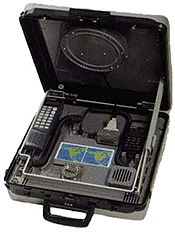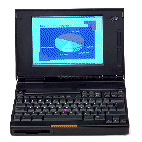

The away-team is able to communicate with the home-team using the MSAT Satellite Communicator. This is a briefcase-sized unit which provides voice and data communications via the MSAT Network.
 MSAT Satellite Communicator by Mitsubishi
MSAT Satellite Communicator by Mitsubishi
The lid of the communicator contains the antenna and it is equipped with a hinge and adjustable support to allow it to be opened to a selected angle. The antenna must be aimed at the MSAT satellite which orbits the equator at a height of 36,000 km. The whole briefcase unit is rotated and the lid raised until a good alignment with the satellite receiver is achieved. A handset, very similar to that used on cellular telephones, provides visual feedback of signal strength and beam identification.
When the unit is aligned a voice call is just dialled in the conventional manner.
The unit has an RS232 connection for making data calls and appears as a 2400 baud modem to the computer equipment. Off-the-shelf data communication software operates as with a typical home modem setup.
While the away-team is situated at the Arctic Watch camp they have AC power available and are thus able to charge their battery packs for the communicator , the computers and the digital camera.
During the second phase of the adventure, canoeing down the Soper River, the team will use solar panels to charge the various batteries and communications will likely be limited somewhat by the need for periodic recharges from the solar panels. Hopefully there will be plenty of bright sunlight.
In addition to regular 35mm film photography, the team is using an Apple Quicktake 150 digital camera to record images from the trip. This camera can capture 16 high resolution or 32 low resolution digital images in its memory.
 Apple's QuickTake 150 Digital Camera
Apple's QuickTake 150 Digital Camera
These images are then transferred to disk using one of the laptop computers
and from there are transmitted to the home team's network server via MSAT data
call.
 IBM Thinkpad 360
IBM Thinkpad 360
The home team retrieves these images and incorporates them in the web pages for the site.
Of special interest are the panoramic 360 degree views called QTVR (QuickTime Virtual Reality) which are produced by the 'stitching' together of a series of individual digital photos, usually 12 in number.
The typical 12 shots are taken as overlapping views using a special levelled turntable mounted on a tripod. A shot is taken at each 30 degree point of a complete rotation. This is usually done with a wide angle lens in order to create sufficient overlap for the 'stitching' process.
The sequence of digital photos is processed by the stitching software which joins each photo to the next by recognizing commonalities in their borders and merging these areas. The process continues until all 12 scenes have been joined together into one long digital image whose head is then joined to its tail.
Viewing software can then 'see' the image from a vantage point inside the image ring. There is some zoom capability as well.
Web viewers will need the Quicktime VR plug-in for their web viewer.